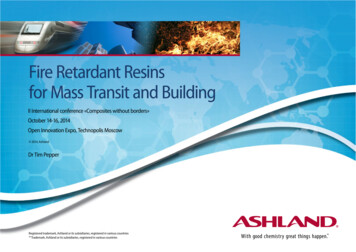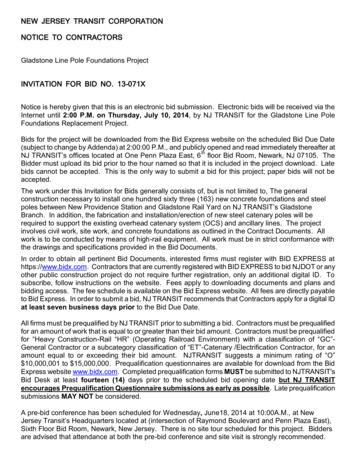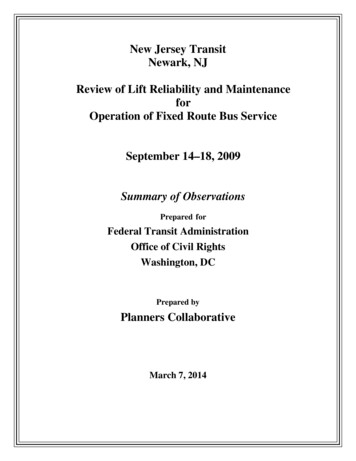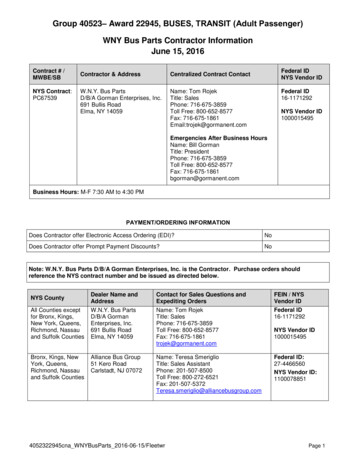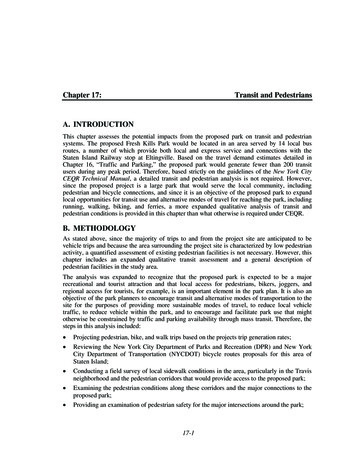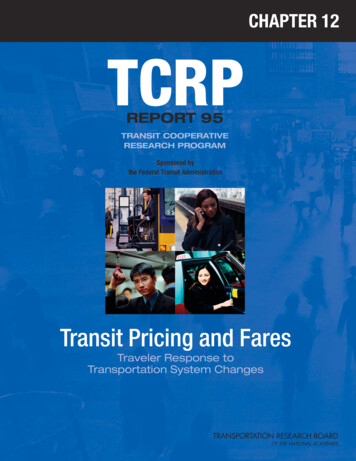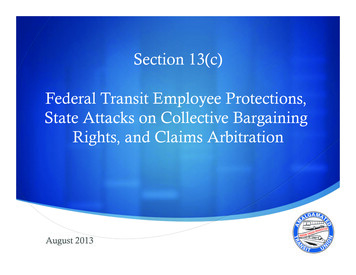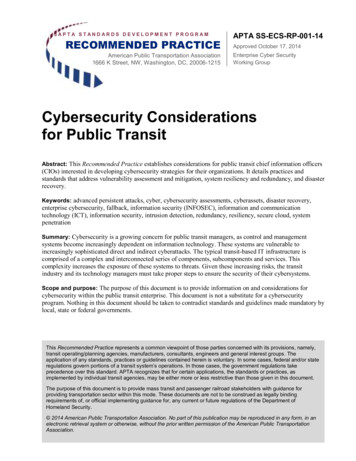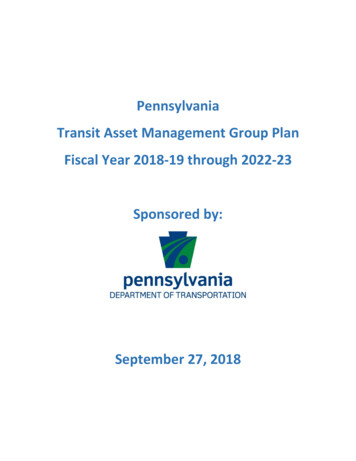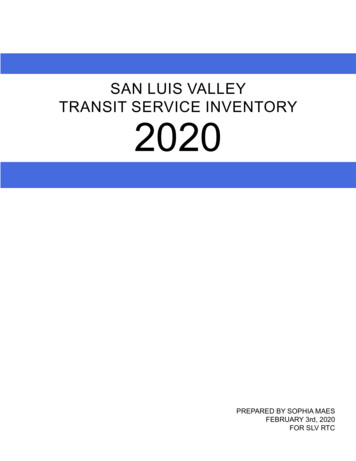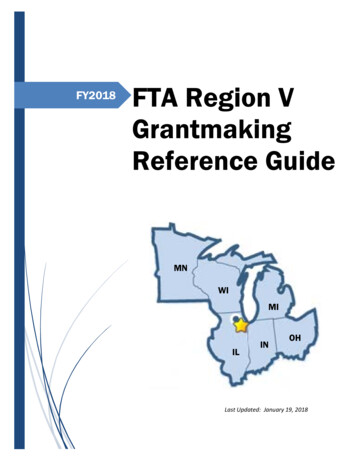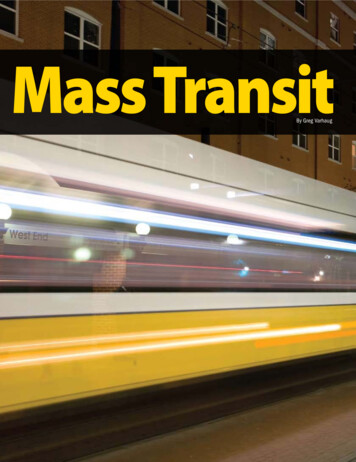
Transcription
Mass TransitBy Greg Varhaug
GreenRethinkfor BusinessThere is a strong argument that it is in thebest interest of Americans to encourage theuse of public transitand carpooling in aneffort to curb congestion and pollution.How does that affectthe Texas business community?Not long ago, the EPA estimatedthat three-quarters of Houstoniansdrove to work alone. The EPA statesthat many times, 20 percent to 30percent of employees can be expectedto switch to using public transit inresponse to encouragement by theiremployers. They also claim thatemployees who use public transportation are less stressed and moreproductive, and that easing trafficcongestion means we aren’t forced tospend as much on roads.Need to MeetMandated TargetsBut perhaps the most importantconsideration cited by EPA for theHouston business community is thatour receiving federal highway fundsis dependent upon our meeting federal pollution requirements. Houston isreportedly not doing too well in thisregard. We could lose federal highwayfunds if we don’t reach federally mandated targets for air pollution. Thinkabout that for a second.For years now, the EPA hasencouraged companies to promote the use of public transit andtelecommuting in the interest offighting pollution. In 2003, theEPA launched an extensive mediacampaign in Houston, including numerous TV news reportsfocusing on Houston’s air-qualityproblems, and the role that areabusinesses can play in the solution.Increasing the use of existingpublic transit resources reducespollution. There are argumentsabout the real energy savingsachieved by public transit basedon how much energy is used inthe construction and maintenanceof roads, rail lines, etc. These areinteresting, but irrelevant – thesesystems are already built, and we’recommitted to maintaining and expanding them.Improving air quality in theHouston area is one of the aimsof the Houston Galveston AreaCouncil, which is the MetropolitanPlanning Organization (MPO) forHarris County and seven surrounding counties. HGAC advisesMetro on matters of transportationplanning. Increasing the efficiencyof public transit is one of HGAC’smain strategies for achieving better air quality.In 2007, the U.S. Censusreported that only five percent ofHoustonians use public transit, asopposed to 17 percent in Seattle.If increasing efficiencies in publictransit is indeed one of our strategies for cleaner air, then we haveroom for improvement.NBIZ Spring 201015
Can a big city like Houston haverates of public transit use comparableto smaller cities like Oakland, California with 16 percent, or Portland,Oregon with 13 percent? Of course,part of that answer depends on Metro’stotal combined carrying capacity,and their ability to respond to futureincreases in demand. Assume that theycan. The real answer depends on the efforts of companies and the communityat large to effectively utilize what we,Houston taxpayers, have bought andpaid for. This isn’t “Save the Whales,”this is “Houston First!”HoustonMetroRailMetro began development of its“METROSolutions”plan in 2001. Area votersapproved the plan in 2003, and it’sscheduled for completion in 2014. The General MobilityProgram gives Metro one quarter of its one cent sales tax formobility projects in Harris County. Metro is authorized to issue 640 million in bonds for use in future projects.The METRO Solutions Phase 2 Implementation Plan includes nearly 30miles of Light Rail Transit (LRT) in the North, East End, Southeast, Uptown, andUniversity corridors.The North Corridor Line will be 5.2 miles long, and will originate at UHDowntown, where the Red Line ends. The route follows Main St., and turnsright on Boundary St., north of Quitman. Then it picks up Fulton St., andcontinues to run north parallel to I 45. The line terminates on Fulton atDeerfield, north of Crosstimbers. This line will take riders to Moody Park,Holy Cross Cemetery, North Line Mall, and Irvington Village.The East End Corridor Line is projected to be about 3 miles long. It will be gin at the Magnolia Transit Center at the corner of 70th St. and Harrisburg. Theline travels north along Harrisburg Ave. It will end where it merges with theSouth East Corridor Line, near the corner of Texas and Bastrop. Metro has notyet determined whether traffic lanes on Harrisburg will be taken or shared.Metro is anticipating 11,000 riders per day on this line.The South East Corridor Line is projected to be 6 miles in length. Fromdowntown, this line runs south down Scott St., where it passes the Universityof Houston’s main campus. It connects to the University Line near this point,which runs east to Texas Southern University, and beyond. The main line willturn east onto Wheeler St., and continue down MLK Blvd.The University Corridor Line was given FTA approval to begin itspreliminary engineering phase in December 2009. This line is projected to run11 miles. Its western terminus will be at US 59 and Hillcroft. It will run alongWestpark, cross north of US 59 at Cummins, and continue west alongRichmond Ave. It crosses back to the south of US 59 and continues alongAlabama. It terminates at its intersection with the South East Corridor Line,next to the UH Downtown campus.The Uptown Corridor Line is projected to run 4 miles along Post Oak,paralleling the West 610 Loop from I 10 to US 59. This route will provideconvenient access to Memorial Park, Houston’s First Baptist Church, and theGalleria area, one of the country’s largest business districts. Construction isscheduled to begin later this year.For further interest in Metro’s RideSponsor programs, email sales@metro.org or counts.aspx.16NBIZ Spring 2010Initiatives by CompaniesMany companies nationwide participate in transit pass programs, inpart, to demonstrate their interest infighting pollution. As a result, companies are often awarded in recognition oftheir efforts, and this generates positivepress. But there are other benefits tocompanies who take part in transit passprograms. Some of these are tangible,like tax benefits for both the companyand the employee; and some less so.Federal tax laws allow private employers, nonprofits, and governmentagencies to provide tax-free transitcommuter benefits to their employeesof up to 230 per month. Because employers receive a tax deduction for thisbenefit, it’s more cost-effective for thecompany to offer commuter benefits totheir employees than it is to offer a salary increase for the same amount. Thecompany’s cost for administering thisprogram can be deducted as a normalbusiness expense. In fact, the reduction in the amount of payroll tax thatthe company pays may well offset thecost of the program.Companies that don’t subsidizetheir employees’ cards can set up a payroll deduction which is then depositeddirectly to the employee’s card account.Employees can effectively trade up to 230 per month in salary for a tax-freebenefit equal to that amount. In thiscase, the employer does not have to paypayroll tax on the amount, and the employee isn’t taxed for the benefit. Thereare also plans under which the cost ofthis benefit is shared.People not eligible to receive thesetax benefits under IRS rules: sole proprietors, the self-employed, partners, twopercent shareholders of corporations,and independent contractors.
In 2008, Metro announced plans to replace 100 buses per year with new MCI hybrids. This hasimproved the weight-carrying capability of the city’s buses, and equates to a lower emission rate perpassenger carried, compared to buses running on natural gas.These programs are easier andless expensive to run today than justa few years ago, thanks to cash-loadable debit cards, and computerizedtracking. Metro’s RideSponsor makesit easier for companies that includeallowances for transportation as partof their employee compensation to administer their transit pass programs.Through RideSponsor, companiescan administer their employees’ useof Metro Q Cards, cash-loadable cardsthat can be used to ride Metro busesand trains.The RideSponsor program haseliminated the need for companies todistribute paper bus passes to theiremployees. The computer programused in RideSponsor provides thecompany with all of the documentation it needs for tax purposes.Jeff Linton, a representative withMetro, recently told me there are136 companies using RideSponsor tomanage their transit pass programs.Of these, about 40 are medium-sizedcompanies, with the remainderincluding some of Houston’s largestcompanies. Most are companies thatalready had transit pass programsin place prior to the introduction ofRideSponsor.18NBIZ Spring 2010Mr. Linton says that responsefrom large companies to the RideSponsor program is very good, andthat Metro is eager to expand theRideSponsor program to include moresmall and medium-sized companies.Metro introduced Q Cards in2007. They have many obvious advantages over older pass media. Q Cardscan be replaced if they’re lost or stolen, as long as the card is registered; ifa card isn’t registered, there is no wayto replace the value of the card. Cardsmust be registered by calling Metro’shelp desk (713-635-4000).Q Cards can be refreshed automatically. Users can arrange to havemoney added at regular times, andyou can set it to refresh a set dollaramount when it reaches a lower limit.They can be loaded with up to 500.And Q Cards allow you to take five freetrips for every 50 trips you take – afteryour 50th trip, your next five bus ortrain boardings are free. The cardsalso track transfers, allowing twohours to complete a transfer.Q Cards also help companies toreduce instances of abuse, if givingaway unused bus tickets rises in yourbook to the level of “abuse.” Q Cardscannot be used twice within five minutes, meaning you can’t pay for yourown trip, then turn around and pay forsomeone else’s. This also reduces thepossibility of unauthorized use.Besides transit pass programs,companies can take other active stepsto encourage their employees to usepublic transportation, or to carpool.Some companies offer special carpoolparking, as well as assisting employees in organizing car pools. Companies can also adjust work schedulesin a variety of ways to accommodatepublic transit, or even to reduce thenumber of trips employees make everyweek. Steps such as these cost companies little or nothing.Changes in Public TransitThe face of public transit haschanged dramatically over the past 30years. When Metro was formed in 1979,they took over a fleet of aging buses,and not much else. Since then, Metrohas built toll roads, plus HOV and HOTlanes. Houston was the first city to useHOV lanes, and this is one of the first actions that Metro took after its creation.They have also added park-and-ride, andthe RideStar vanpool program.
Metro operates a fleet of 737 vans,which serve 7,500 riders through itsRideStar program. They offer ridematching programs to help commuters to better utilize RideStar. Metrois keeping an eye on developmentsin hybrid technology for its van fleet,but has not yet made specific plans topurchase hybrid vans.Metro experimented with natural gas technology (CNG and LNG)in a move to reduce emissions fromtheir buses. Within two years, Metrodecided this wasn’t cost-effective. In2002, Metro made plans to acquirediesel-electric hybrids, which useultra-low sulfur diesel. In 2008, Metroannounced plans to replace 100 busesper year with new MCI hybrids. Thishas improved the weight-carryingcapability of the city’s buses, andequates to a lower emission rate perpassenger carried, compared to busesrunning on natural gas.Metro has engaged in a variety ofcommunity outreach efforts, and hasa number of programs to help specificpopulations. The Q Card programhas been actively promoted to collegestudents. Metro has worked to accommodate people who are mobilityimpaired. And on some lines, peoplecan take their bikes on the bus. Otheroutreach efforts include pages onFacebook and Twitter, and a “MetroMatters” TV show on local cable,which includes a special edition inSpanish. No, Metro isn’t “your father’sbus company” anymore.Metro operates a fleet of 737vans, which serve 7,500 ridersthrough its RideStar program.The Future of MetroThough Metro’s vision is that ofserving the entire Houston area, theircurrent efforts, which is to say theirinitial efforts, are centered on makingit easier to get downtown. The majority of Metro’s bus lines, and all of theirpark-and-ride routes, go downtown.Metro Solutions is the plan adopted by the Metro Board of Directorsand approved by voters in 2003. Phase2 of this plan was started in 2005, andis intended to speed the completion oftransit projects versus the timetablesoriginally proposed by Metro. ThePhase 2 plan includes nearly 30 milesof light rail transit along the North,East End, Southeast, Uptown, and University corridors.The Phase 2 plan also calls for 28miles of commuter rail transit alongUS-290, and along US-90A. The planalso calls for expanding Signature(express) bus service, construction of10 new transit facilities, and to convertHOV to HOT lanes. Phase 2 completionis due in 2012. Metro is reportedly developing plans for a Galveston line.Similar Situations inDallas and ElsewhereThe discussion so far has centered completely on Houston, but thesituation in Dallas is almost identical. Dallas’ DART system was createdin 1984, five years after Metro. Eachof these regional transit authoritieswas funded with a one cent salestax, which their member cities havefaithfully paid ever since. The boardsof both agencies immediately draftedplans that included ambitious lightrail projects.Like Metro, one of DART’s expresspurposes at the time of its creationwas as part of a comprehensive plan tohelp control air pollution. Though notas heavily industrialized as Houston,Dallas faces very similar problems withregard to air quality.NBIZ Spring 201019
TheDARTDifferenceDART’s programs for area businesses areorganized a little differently than thoseat Houston’s Metro, although the typesof services offered are essentially the same.DART has representatives who work withcompanies in the DART service area to facilitate thesales of annual and monthly passes, vanpool services, andto assist with car pools and ride matching.DART’s programs include their Emergency Ride Home, trip planning,and training for those in charge of the company’s transit pass program.DART’s Employee Preferred Annual Pass is geared to the needs of largecompanies, while their Annual FlexPass is available to smaller companies,those needing between five and 24 passes.DART has three different pass types. These differ depending on whichservices you want to use, and where you want to go. For instance, you’llneed a Regional Pass to take TRE to Fort Worth.DART currently has 59 large companies enrolled in their Preferred An nual Pass program, 59 smaller companies enrolled in their Annual FlexPassprogram, and 58 companies in the Monthly Pass program. DART also runs173 vanpool groups.For more information about DART’s employer transit pass programs, call 214-747-RIDE (7433) orvisit their website at www.dart.org. Click on Employer Pass Information under the Fares and Passestab on the DART home page. Or, go to Z Spring 2010DART offers programs to individuals and businesses very similarto those offered by Houston Metro.DART offers “Monthly Pass” programs, as well as a “Companywide Annual Pass,” and an “Individualized Annual Pass.” Both are photo ID cards.The “Companywide” pass includes an“Emergency Ride Home” program,which allows employees two free cabrides per year within 50 miles.DART says that their monthlypass programs help to increaseemployee productivity, reduce thenumber of employees who come inlate to work, and reduce the numberof absences due to car problems, inaddition to other benefits.DART has made it easy to enrollin the program. The company signsan agreement, then submits a listof authorized riders to DART. Thecompany can either provide employeephotos to DART, or DART will go tothe company to take employee photos.DART states that, “The corporateannual pass is a win/win for everyone:Employers get passes for less than thegeneral public and get tax benefits forthe amount of their subsidy. Employees also get a discounted pass and theportion they pay can be paid for withpre-tax dollars. Riders save on wearand tear on their personal autos andmost insurance companies offer discounts to car owners that use transitat least three times per week.”The situation in Dallas and Houston is very similar to that of citiesacross the country. Transit authorities nationwide are faced with the
problem of how to decrease harmfulemissions, and keep their cities incompliance with state and federalpollution standards.Transit authoritiesnationwide are facedwith the problem of howto decrease harmfulemissions, and keep theircities in compliance withstate and federal pollutionstandards.Making Transportation GreenerThere is no real debate over thenecessity to switch to cleaner energy.As much as anything else because“dirty” energy is running out worldwide. This is an inescapable fact, andis an even more compelling reasonthan pollution concerns to commitourselves to developing alternativeenergy resources.And we have done just that. Thefederal government is funding newalternative energy projects, andenergy companies are investing inalternative energy research. There isno reason to believe that these effortswon’t produce positive results overtime, possibly within a short time.Many of the contentions surrounding the plans of DART andMetro have to do with their plans forbuilding rail, which is powered byelectricity. At present, most electricity comes from burning fuel or coal.This complicates arguments that railis greener than roads.An extensive rail network powered by electricity becomes cleaneras more of that electricity is generated using cleaner technologies. Itwill be a gradual shift. To the extentthat our transportation network ispowered by electricity, that networkbecomes cleaner as power generation in the region becomes cleaner.And although many people are stillunaware of it, Texas is leading the wayin the development of alternative energy, especially wind power. Accordingto the Federal Reserve Bank, in 2009only 3.5 percent of total electricity inTexas came from wind. But Dallas andHouston are among the top purchasersof wind-generated energy nationwide.In January of 2008, the EPA reportedthat Dallas was purchasing as muchas 40 percent of its power from windbased sources, and in Houston as muchas 20 percent of the power purchasedwas generated by wind. There is no reason to believe that these percentageswon’t increase in the coming years.than running a bus fleet. Initial costsfor upgrading a bus system are almostcertainly lower. But any attempt to analyze the relative cost of electric rail hasto take fuel prices into account.Oil prices are subject to a numberof perverse influences, including market speculation and outright manipulation. Very few people in the oil businesswould argue that oil prices are governed by free-market factors alone. Thisfact complicates the attempt to justifyrail (or anything else) by a supposedsaving in the cost of energy required torun the system. And while it’s difficultto project future fuel costs, no one believes that fuel prices are going down.The days of cheap oil are over for good.Businesses whose core operationsdon’t produce a significant amount ofpollution may believe that there’s nothing they can do to help. Because theyaren’t the source of the problem, theysee no role for themselves in its eventualsolution. But pollution is everybody’sproblem, and the business communitiesof Houston and Dallas have a chance tobe a part the solution. NGreg Varhaug has written software instructionmanuals and procedural manuals for manyHouston energy and manufacturing companies, and has designed websites for smallercompanies. A professional musician for over25 years
Title: Mass Transit Author: Greg Varhaug Subject: There is a strong argument that it is in the best interest of Americans to encourage the use of public transit and
